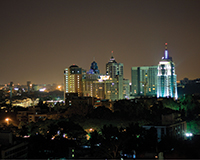 It’s all change in Asia, with shifts in economy, new sectors emerging and a housing bubble
It’s all change in Asia, with shifts in economy, new sectors emerging and a housing bubble
Times are changing in the East. While China’s economic slowdown is partly attributable to the demise of state-owned heavy industry and low-end manufacturing, growth in the services sector (8% since 2012) is helping to stave off the daunting prospect of a financial crisis. Meanwhile, “new economy” sectors such as IT, biotech and manufacturing of consumer goods could bring about an increase in gross domestic product when China updates its GDP methodology at its next revision in 2018.
“The whole industry is changing. Large businesses are shifting factories to south-east Asia, and China is looking to transform its IT and biotech sectors,” says David Ji, Knight Frank’s head of research and consultancy in Greater China.
A large oil importer, India has profited from lower prices. The country knocked China off another perch in April, becoming the top destination for international capital investments, according to the foreign direct investment league table, with $62bn of greenfield investment in 2015. The economy has been stimulated by the development of the IT and retail industries, and the IT sector alone is expected to reach $350bn in annual revenue by 2025, almost triple its current output. As a result, India remains a hot prospect for commercial real estate investment.
In south-east Asia, the economic outlook is varied, with high-performing nations such as Vietnam and the Philippines leading the way. Growth in GDP for the region is expected to reach 4.5% and 4.8% in 2016 and 2017 respectively. FDI is rising in Vietnam, up by 30.4% in the first eight months of 2015, and GDP growth in the Philippines is projected to rise to 6% in 2016.
Indonesia and Malaysia have suffered the most from the slowdown in China, as demand for commodities drops. Commodities account for three-fifths of Indonesian exports, and Malaysia, Asia’s biggest oil exporter, continues to suffer despite a slight rise in oil prices from $30 to $45 per barrel in April.
Talk of a housing bubble in Japan is getting louder, and a declining population and home vacancy rate of 13% are unlikely to inspire confidence in the market. Negative rates and a lack of investment options in Tokyo are slowing growth.
Commercial
Retail and hospitality sectors in Japan are thriving as a result of nearly 35% depreciation in the yen since 2013, boosting tourism and dragging Chinese tourists away from Hong Kong, where retail sales and visitor numbers fell by 13.6% in early 2016. Office rents in top-tier cities such as Beijing and Shanghai are also expected to rise by 5%.
“There has been a resurgence of investors going into China,” says Knight Frank’s Ji, who points towards the office market in the first-tier cities of Shenzhen and Beijing, where vacancy rates dropped to 9.7% and 4.3% respectively in Q1 2016.
Residential
A growing population in Saudi Arabia has increased demand for housing and land values are rising at a rate of 7% per year, resulting in a housing crisis that has required state intervention. The population is expected to rise from 31m to 37m in the next 10 years, and leading cities Jeddah and Riyadh are crying out for investment as the government seeks to attract foreign developers to increase projects from 150,000 units per year to 300,000.
In Abu Dhabi, investors are seeing significant returns in quality apartments, with yields of 9% in the Al Reef Downtown and Al Muneera areas. There is a gross yield of 6% across the city, and a 2% increase in apartment rental rates in Q1 2016.
Growth areas
According to Forbes, the Indian economy is set to become the most important in the world, as the workforce rises to 900m people by 2020. “The IT sector will continue to drive the demand for real estate in the key office markets,” says Samantak Das, Knight Frank’s director of research for India.
Risks and challenges
Corruption is rife in India, and political stability seems a distant prospect, with predictable results expected in the latest regional elections. In West Bengal, video footage has been released of members of the Trinamool Party taking bribes. Despite this, the party looks likely to be granted another five years in office.
The economic slowdown in China will keep investors on their toes as further decline is likely to have an effect throughout the continent. Despite optimism about economic growth in 2016, $1.3tn of Chinese corporate debt looms.
Must-have contacts
James Macdonald, head of research China, Savills Shanghai, james.macdonald@savills.com.cn
Bob Flanagan, director, Colliers International, bob.flanagan@colliers.com
Hiroshi Okubo, head of research, Japan, CBRE, hiroshi.okubo@cbre.co.jp
Somy Thomas, managing director, valuation and advisory services, India, Cushman & Wakefield, somy.thomas@ap.cushwake.com
City guide: Bengaluru
Overview
Known as the Silicon Valley of India, Bengaluru is the third most populous city in the country, with 11.5m inhabitants. A burgeoning IT sector and growing population make it an attractive prospect for real estate investment this year.
Why invest?
Bengaluru has overtaken Mumbai as the strongest real estate investment prospect in India, according to PwC’s Emerging Trends in Real Estate Asia Pacific report. Large multinationals such as Microsoft, IBM and Goldman Sachs have been drawn in by affordable office rents, a large talent pool and consistent population growth.
Bengaluru is unlikely to be overly fazed by China’s economic slowdown, and its e-commerce industry is expected to grow by 35% over the next five years, crossing the $100bn mark by 2020. Ongoing developments in the city’s infrastructure, including greater metro rail connectivity, are likely to boost the residential property market.
The numbers
50,000 jobs to be created by e-commerce industry by 2018
4m sq ft of office space was leased in Q1 2016
6% office vacancy rate
The opportunities
The growing IT industry and influx of foreign investment mean demand for commercial space remains high. Despite a massive pipeline of commercial property development, with around 40m sq ft of office space in various stages of planning and construction, absorption rates are high and vacancy rates of only 6% are not expected to increase, according to PwC.
While infrastructure developments are in the works, current transport links are not sufficient for carrying the vast workforce to and from the commercial hubs. For this reason, areas such as Thanisandra and the Panathur-Varthur belt, in close proximity to commercial districts, represent viable options for residential real estate investment.
Stand-out scheme
Bengaluru Metro Rail Phase I is a 42km metro project comprising a 24km line connecting the Hessarghatta Circle in the north to Puttenahalli in the south and an 18km line connecting Byappanahalli in the east with Mysore Road in the west. This represents the beginning of several developments to improve the city’s infrastructure and create transport links between the commercial district and the larger metropolitan area.
Top tips
- Bengalaru has a burgeoning craft beer scene. Visit microbrewery Windmills Craftworks in the Whitefield district to sample some local brews.
- Take a stroll in the historical Cubbon Park. Established in 1870, the 120ha garden is in the city’s central business district.
- Check out the Swee Dodda Ganapathi temple, which houses a large statue of Ghanesh.










